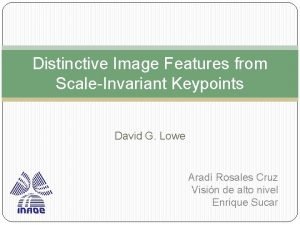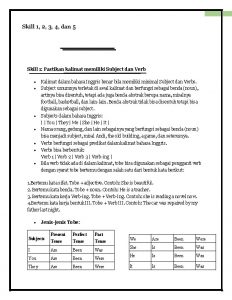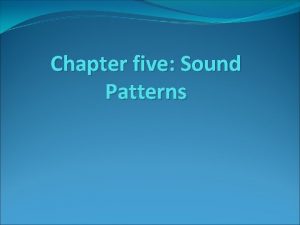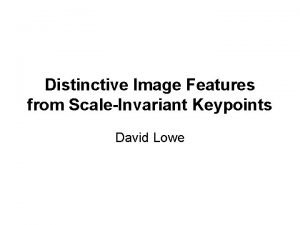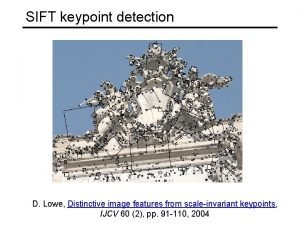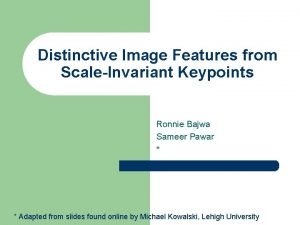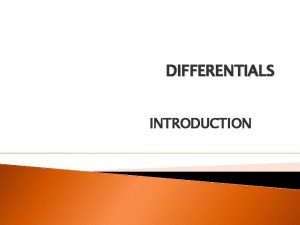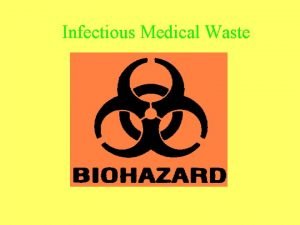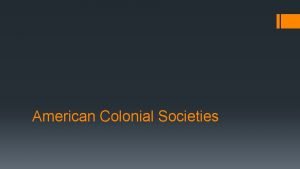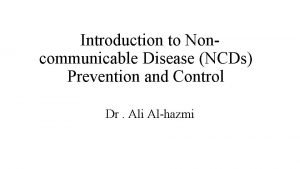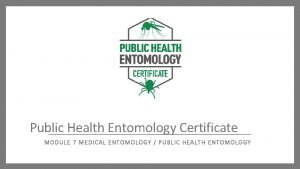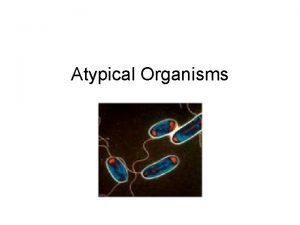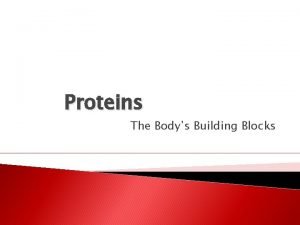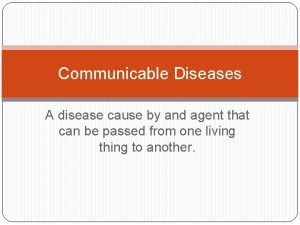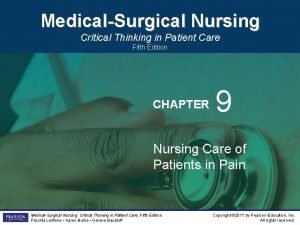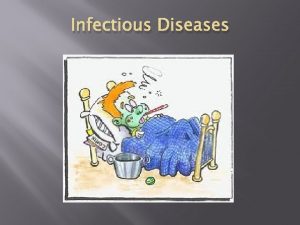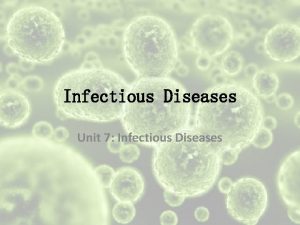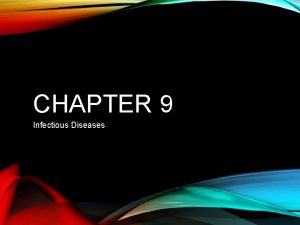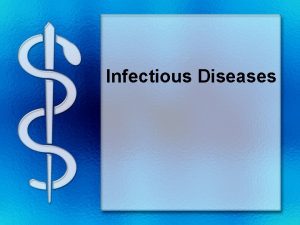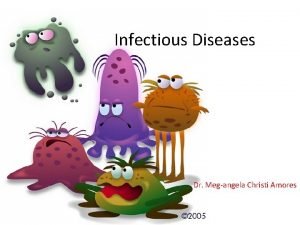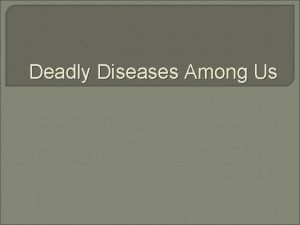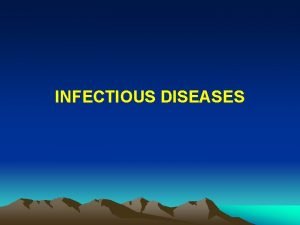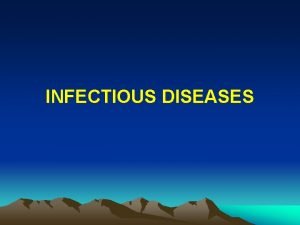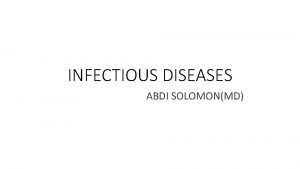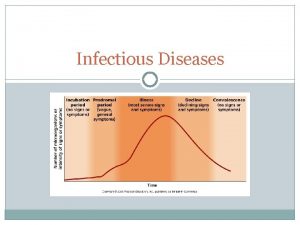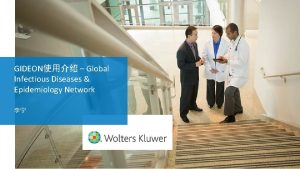INFECTIOUS DISEASES Infectious diseases infectious diseases are distinctive




























































- Slides: 60

INFECTIOUS DISEASES

Infectious diseases infectious diseases are distinctive enough to be identified clinically. Most pathogens, however, can cause a wide spectrum of clinical syndromes in humans. Conversely, a single clinical syndrome may result from infection with any one of many pathogens. Influenza virus infection, for example, causes a wide variety of respiratory syndromes that cannot be distinguished clinically from those caused by streptococci, mycoplasmas, or more than 100 other viruses.

1. It is necessary to use laboratory methods microbiological to identify a specific etiologic agent. 2. Diagnostic medical microbiology is the discipline that job of the clinical microbiology laboratory identifies etiologic agents of disease. The is to test specimens from patients for microorganisms that are, or may be, a cause of the illness and to provide information (when appropriate) about the in vitro activity of antimicrobial drugs against the microorganisms identified


The staff of a clinical microbiology laboratory should be qualified to advise the physician as well as process specimens. The physician should supply salient information about the patient, such as age and sex, tentative diagnosis or details of the clinical syndrome, date of onset, significant exposures, prior antibiotic therapy, immunologic status, and underlying conditions. The clinical microbiologist participates in decisions regarding the microbiologic diagnostic studies to be performed, the type and timing of specimens to be collected, and the conditions for their transportation and storage. Above all, the clinical microbiology laboratory, whenever appropriate, should provide an interpretation of laboratory results.

Manifestation of Infection An indication of the existence, presence of something, especially an illness. ) ( The manifestations of an infection depend on many factors, including the site of acquisition or entry of the microorganism; organ or system tropisms of the microorganism; microbial virulence; the age, sex, and immunologic status of the patient; underlying diseases or conditions; and the presence of implanted prosthetic devices or materials. The signs and symptoms of infection may be localized, or they may be systemic, with fever, chills, and hypotension. In some instances the manifestations of an infection are sufficiently characteristic to suggest the diagnosis; however, they are often nonspecific.

Microbial Causes of Infections may be caused by bacteria (including mycobacteria, chlamydiae, mycoplasmas, and rickettsiae), viruses, fungi, or parasites. Infection may be endogenous or exogenous. In endogenous infections, the microorganism (usually a bacterium) is a component of the patient; s indigenous flora. Endogenous infections can occur when the microorganism is aspirated from the upper to the lower respiratory tract or when it penetrates the skin or mucosal barrier as a result of trauma or surgery. In contrast, in exogenous infections, the microorganism is acquired from the environment (e. g. , from soil or water) or from another person or an animal. important to establish the cause of an infection, the differential diagnosis is based on a careful 1. Although it is 2. history, physical examination, and appropriate radiographic and laboratory studies, including the selection of appropriate specimens for microbiologic examination. Results of the history, physical examination, and radiographic and laboratory studies allow the physician to request tests for the microorganisms most likely to be the cause of the infection.

SAMPLE COLLECTION, PROCESSING AND STORAGE

Specimen Selection, Collection and Processing Specimens selected for microbiological examination should reflect the disease process and be collected in sufficient quantity to allow complete microbiologic examination. The number of microorganisms per milliliter of a body fluid or per gram of tissue is highly variable, Swabs, although popular for specimen collection, frequently yield too small a specimen for accurate microbiologic examination and should be used only to collect material from the skin and mucous membranes.

Specimen Selection, Collection and Processing cont……. . contamination Because skin and mucous membranes have a large and diverse indigenous flora, every effort must be made to minimize specimen contamination during collection. Contamination may be avoided by various means. The skin can be disinfected before aspirating or incising a lesion. Alternatively, the contaminated area may be bypassed altogether. Examples of such approaches are transtracheal puncture with aspiration of lower respiratory secretions or suprapubic bladder puncture with aspiration of urine. It is often impossible to collect an uncontaminated specimen, and decontamination procedures, cultures on selective media, or quantitative cultures must be used.

Specimen Selection, Collection and Processing cont……. . If possible, specimens should be collected before the antibiotics. administration of Above all, close communication between the clinician and the microbiologist is essential to ensure that appropriate specimens are selected and collected and that they are appropriately examined.

Specimen Selection, Collection and Processing cont……. . Sample Collection, such as handling, labeling, processing, aliquoting, storage, and transportation, may affect the results of the study If case sample are handled differently from controls samples, differential misclassification may occur

Information linked to Sample Time and date of collection Recent diet and supplement use, current medication use History of any disease Recent medical illness Storage conditions


Quality Assurance Adoption of standardized operation procedures (SOP) for each aspect of biospecimen handling Stored specimens should be tested on a regular basis Aliquoting material into multiple small vials


Quality Assurance Storing each person’s specimen in at least two different physical locations to avoid the likelihood of loss of a large volume of specimen as a result of accidental thawing due to freezer failure or electronic blackout.

Storage It is critical to maintain careful records of the identity and location of all materials, with Øparticular attention to storage history, Øoccurrence of temperature fluctuation Ømonitoring of stored control specimen in order to check the effects of storage duration.

Storage Samples stored on the top of the freezer may be exposed to more extreme temperature fluctuation then those stored at the bottom.

Timing For studies of hormones, which have �hourly, �daily and �monthly timing of sample collection is critical. It is critical to obtain information at the time of specimen collection, e. g. , time and date of draw, volumes and type of specimen, medical illness, medication use etc…….

Processing The sample processing depends on the marker needed. Investigator must design studies to fit the requirement of the critical biomarkers.

Types of Biospecimens individuals who already diagnosed Collection of biospecimens from individuals who already diagnosed as having illness to characterize the history of the disease. Many collections of tissues including tumor and normal tissues. It will be much better if the related epidemiological data are also collected.

Types of Biospecimens: Blood skilled technicians The use of skilled technicians and precise procedures when perform phlebotomy are important because painful, prolonged or repeated attempts at venepuncture can cause patient discomfort or injury and result in less than optimum quality or quantity of sample.

Types of Biospecimens: Blood Plasma Serum Lymphocytes Erythrocytes Platelets

Blood Sample Collection When a large amount of blood sample needed, an evacuated tube system with interchangeable glass tubes can be used to avoid multiple venepunctures. Evacuated tubes are commercially prepared with or without additives and with sufficient vacuum to draw a predetermined blood volume per tube.

Sterile Blood needles; Sterile Syringes; Plain Vacutainer; Blood Tubes; Alcohol Prep Pads; Tourniquet

Blood Collection: Color-code Tubes Red-top tubes contain no additives. These tubes are used for tests performed on serum samples and DNA. When you use the red-top tubes, the sample can be placed for 1 -2 hours so that the serum and blood clots will be separated. Blood clots can be used for DNA analysis.

Blood Collection: Color-code Tubes Lavender-top tubes contain EDTA, commonly used clinically for complete blood cell counts. This is the way to obtain for DNA extraction, plasma Biochemistry red blood cells for other assays.

EDTA is a anticoagulant. It works by calcium chelation and is used clinically in heamatology studies. It is well suited Ø to DNA-based assays, Ø but has problems for cytogenetic analysis.

Blood Collection: Color-code Tubes Green-top tubes contain heparin Heparin is an anticoagulant. There are some reports of problems with heparin in PCR assays, studies generally find that there are no major difference in the use of EDTA or heparin

Blood Collection: Color-code Tubes cont…. Blue-top tubes contain sodium citrate and citric acid Citrate also works by calcium chelation and is used in coagulation studies and blood banking.

Blood Collection: Color-code Tubes cont…. Black-top tubes contain sodium oxalate

Blood Collection: Color-code Tubes cont…. Yellow-top tubes contain acid-citratedextrose (ACD) solution.

Blood Collection: Color-code Tubes cont…. Grey-top tubes contain a glycolytic inhibitor.

Dried Blood Spot Dried blood spot specimens: Small quantities of blood adequate for the characterization of DNA. Not require venepuncture or low temperature condition during collection, processing and storage Can be from whole blood or antocoagulated with EDTA

Dried Blood Spot Blood specimen is spotted onto clean slides or paper or cotton cloth. Transported and stored at room temperature Serves as a good source of high-molecularweight DNA A quantity of 50 ul of dried blood can provide 0. 5 ug DNA, sufficient for multiple PCR-based assays

Processing Serum fatty acids should be measured Ø within 2 weeks at 4 degree C, Øwithin a few months at – 20 degree C, and Ø within a year at – 80 degree C

Urine Collection Urine is an ultrafiltrate of the plasma. It can be used Øto evaluate and monitor body metabolic disease process, Øexposure to xenobiotic agents,

Urine Collection Ø Urine collection is not readily obtainable. However, it is more inconvenient than blood collection. ØThe type of urine selected and the collection procedure used to depend on the tests to be performed.

Urine Collection First morning Random Fractional timed

Urine Collection Clean and dry plastic or glass containers (503000 ml capacity) A preservative may be needed depending on the proposed assay Total volume must be recorded The specimen well mixed to ensure homogeneity Aliquots for specific assays

Urine Collection Time frame for measurement of proposed assay. Microbial contamination Cost of storing large volumes of material effect of long-term storage on quantitative or qualitative detection

Tissue Collections Confirming clinical diagnosis by histological analysis Examining tumor characteristics at chromosome and molecular level

Tissue Collections It requires to collect more materials than it is necessary for pathological evaluation When possible, the tissue sample should contain both tumor and normal tissues to permit to study different characteristics of the two tissues.

Tissue Collections Formalin-fixed paraffin-embedded tissue specimens The tissue is embedded in frozen section support media and stored at – 70 degree C Snap frozen tissues.

Hair Easy available biological tissue whose typical morphology may reflect disease conditions within the body Provides permanent record of trace elements associated with normal and abnormal metabolism A source for occupational and environmental exposure to toxic metals

Hair analysis provides long-term information from months to years, concerning both the severity and pattern of drug use. Hair roots can be optimal source of DNA for PCR analysis and permit easy collection, transportation and low overall costs.

Nail Clippings Toenail or fingernail clippings are obtained in a very easy and comfortable way. They do not require processing, storage and shipping condition and thus suitable for large epidemiological studies

Nail Clippings Trace elements Selenium levels Arsenic levels Less likely to be contaminated by environmental factors

Saliva It is an efficient, painless and relatively inexpensive source of biological materials for certain assays It provides a useful tool for measuring endogenous and xenobiotic compounds

Saliva Measurements Corticosteroids Antibodies to HIV-1






Feaces Certain cells of interest Infectious markers Oncogenes

Shipping Sample shipping requirements depends on the time, distance, climate, season, method of transport, type of specimen and markers to be assayed. Polyurethane boxes containing dye ice are used to ship and transport samples that require low temperature. For samples require very low temperature, liquid nitrogen container can be used. The quantity of dry ice should be carefully calculated, based on estimated time of trip.

Safety Protect specimen from contamination Workers safety, HIV, HBV

Procedures Standardized approaches in order to ensure quality control Biological specimen collection manual Manuals for field trip preparation, packing and shipping samples Protocols for lab assays
 Antigentest åre
Antigentest åre Epidemiological triad
Epidemiological triad Certain infectious and parasitic diseases
Certain infectious and parasitic diseases Physical landforms of africa
Physical landforms of africa The smallest, distinctive sounds of any language are:
The smallest, distinctive sounds of any language are: Distinctive competencies
Distinctive competencies Vocal instrumental music similarities of pakistan and india
Vocal instrumental music similarities of pakistan and india Organisational capabilities
Organisational capabilities Chapter 2 building health skills and character
Chapter 2 building health skills and character Why do religions have distinctive distributions?
Why do religions have distinctive distributions? A classification of dance is suitable for special occasions
A classification of dance is suitable for special occasions Linguistic relativity examples
Linguistic relativity examples Distinctive competencies
Distinctive competencies What makes a landscape distinctive
What makes a landscape distinctive Distinctive image features from scale-invariant keypoints.
Distinctive image features from scale-invariant keypoints. Id is based on moral values
Id is based on moral values Threshold and distinctive capabilities
Threshold and distinctive capabilities The distinctive characteristics of the artwork
The distinctive characteristics of the artwork Distinctive spirit of an institution
Distinctive spirit of an institution The spices flavoring the meal were quite distinctive
The spices flavoring the meal were quite distinctive Distinctive features phonology
Distinctive features phonology Landforms of the southwest
Landforms of the southwest David lowe sift
David lowe sift Sift keypoint detector
Sift keypoint detector Why do religions organize space in distinctive patterns?
Why do religions organize space in distinctive patterns? Distinctive image features from scale-invariant keypoints
Distinctive image features from scale-invariant keypoints Competitiveness, strategy, and productivity
Competitiveness, strategy, and productivity Chapter 13 key issue 2
Chapter 13 key issue 2 Ebv
Ebv Infectious canine hepatitis in dogs
Infectious canine hepatitis in dogs Infectious stunting syndrome
Infectious stunting syndrome Infectious nucleic acid
Infectious nucleic acid Stages of infection
Stages of infection Hennepin county infectious disease manual
Hennepin county infectious disease manual Infectious disease board review
Infectious disease board review Infectious mononucleosis
Infectious mononucleosis Waste management definition
Waste management definition Chapter 26 infectious disease prevention and control
Chapter 26 infectious disease prevention and control Hpps logo
Hpps logo Smallest infectious agent
Smallest infectious agent Infectious disease
Infectious disease Stages of infectious disease
Stages of infectious disease Infectious disease quality controls
Infectious disease quality controls Quizlet
Quizlet Papillomitosis
Papillomitosis Global alliance against chronic respiratory diseases
Global alliance against chronic respiratory diseases Diseases spread by columbian exchange
Diseases spread by columbian exchange Myth and fallacies about non-communicable diseases
Myth and fallacies about non-communicable diseases Ascaris lumbricoides
Ascaris lumbricoides Albugo eye
Albugo eye Chapter 21 mental health diseases and disorders
Chapter 21 mental health diseases and disorders Public health entomology certificate
Public health entomology certificate Is hemophilia communicable or noncommunicable
Is hemophilia communicable or noncommunicable Migrants
Migrants Protein deficiency diseases
Protein deficiency diseases Examples of communicable diseases
Examples of communicable diseases Columbian exchange restaurant names
Columbian exchange restaurant names Normal gingiva in child
Normal gingiva in child Chapter 10 lymphatic system diseases and disorders
Chapter 10 lymphatic system diseases and disorders Where is kidney pain felt diagram
Where is kidney pain felt diagram Chapter 24 sexually transmitted diseases and hiv/aids
Chapter 24 sexually transmitted diseases and hiv/aids














